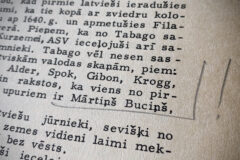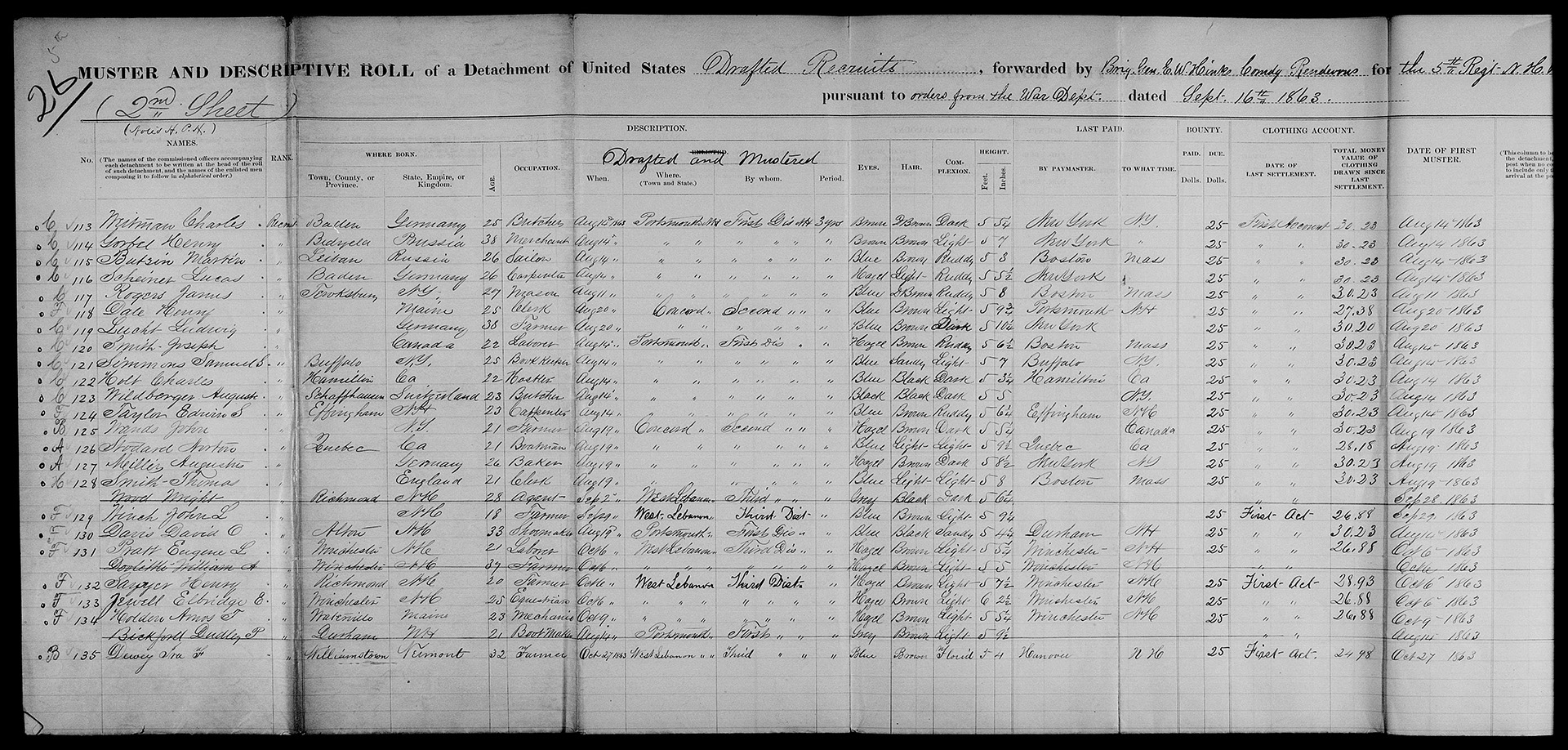One of the legends about the early Latvian presence in the United States is that among the first to die in the American Civil War was a man named Mārtiņš Buciņš. Perhaps he fought for the Union Army, or maybe he served with the Confederate Army, or possibly he was a civilian who had become a casualty of the conflict. But he was Latvian and that’s what mattered.
Years ago, my father gave me his copy of Amerikas latvieši, 1888-1948, a 1958 book by journalist and historian Osvalds Akmentiņš. I recall coming across the name of Mārtiņš Buciņš on page 17, underscored in pencil by my father, who also had placed an exclamation mark in the margin.

“It is written,” Akmentiņš noted, “that one of the first victims of the Civil War was Mārtiņš Buciņš, which is a Latvian name.”1
The factoid saw occasional mention in the Latvian émigré press especially from the 1950s through the 1970s. However, the legend may be only partly true. Buciņš, I believe, was not among the first to die during the Civil War, but served as a sailor with the Union’s Potomac Flotilla until a tragic accident took him and most of his fellow crew to a watery grave. Records that support this version but that were difficult for earlier researchers to obtain have been digitized in recent years and now are readily available.
Perhaps the earliest mention of Buciņš and his role in the Civil War was in the 1945 book One America: The History, Contributions, and Present Problems of Our Racial and National Minorities by Francis James Brown and Joseph Slabey Rouček. In Rouček’s chapter on Latvians, he wrote, “It is interesting, however, to note that a Latvian, Martins Bucins, of Liepaja or Libau, was one of the first to be killed in the Civil War.”2 The source of Rouček’s information remains unknown.
The historian Edgars Andersons, writing in the cultural journal Ceļa Zīmes in March 1950, mentioned that Buciņš was one of the first to fall in 1861. He referred to historical materials, but did not specifically cite the source. In a passage suggesting that he had fought with Union forces, Buciņš was further identified by Andersons in the 1953 book Cross Road Country Latvia as “probably a sailor.”3
Several writers repeated the legend in the following years, including Akmentiņš in his book. A few attempted to look further into the Buciņš story.
For example, Verners Vītiņš of the University of Minnesota Library in 1961 reportedly determined that Buciņš, fighting for the Confederate Army, had been the first to fall during the Civil War. His findings were reported in a short item in the newspaper Laiks.4 Akmentiņš, in a letter to the editor of the newspaper, countered that Buciņš likely did not fight for the Confederate Army. He noted that Buciņš was not among those killed in action on either side of the conflict, according to The War of the Rebellion: A Compilation of the Official Records of the Union and Confederate Armies, a 128-volume work published between 1880-1901. Akmentiņš concluded that Buciņš therefore must have been a civilian who died as a result of the war.5
Andersons in 1976 further claimed Buciņš was mortally wounded during the infamous First Battle of Bull Run in July 1861 and so became the first victim of the Civil War.6

The claim that Buciņš was the very first soldier, or even among the first, to die in the Civil War is wrong. The first Union soldier to die was Daniel Hough, an Irish immigrant stationed with the Union Army at Fort Sumter, South Carolina. He was killed in an accident on April 14, 1861, when a cannon exploded. The first Union soldier killed by enemy fire was Thornsbury Bailey Brown. Meanwhile, the first Confederate soldier to fall was Henry Lawson Wyatt, an enlistee from North Carolina.
The first civilian deaths during the war occurred in April 1861 during the Pratt Street Riots in Baltimore, Maryland, but no one named Mārtiņš Buciņš was among the dozen men killed.
Civil War records show that Mārtiņš Buciņš — or rather, Martin Butzin or Martin Butsin — did exist. His name is easily found in the online Civil War Soldiers and Sailors System maintained by the National Parks Service and based on transcriptions from service records held by the National Archives and Records Administration.
It is important to take into account that the modern Latvian spelling of his surname, Buciņš, would most likely have been written as Butzin in the old Gothic orthography used by Latvians in the 19th century.
The online record shows Martin Butzin as having served in the Union Army with the 5th Regiment of the New Hampshire Infantry.
Further information can be found through online genealogical services such as FamilySearch.org and Ancestry.com. Civil War service and pension records7 show that 26-year-old Martin Butzin enlisted on August 14, 1863, while in Portsmouth, New Hampshire. He had brown hair, blue eyes and a ruddy complexion. Butzin stood 5 feet, 3 inches (1.6 meters). He lived in Boston but was born in Libau, Russia (now Liepāja, Latvia).
In April 1864, he transferred to the U.S. Navy as a landsman, or naval recruit, with the Potomac Flotilla at Point Lookout, Maryland. Butzin’s description in the rendezvous or naval enlistment record matches the information from New Hampshire.8 Service records further show he served first on the USS Matthew Vassar and then on the USS Tulip.
That’s where the story takes a tragic turn. According to A History of the Fifth Regiment New Hampshire Volunteers, in the American Civil War, 1861-1865, Butzin was among the crew killed on November 11, 1864, when the USS Tulip’s starboard boiler exploded and the ship sank in the Potomac River off Ragged Point, Virginia.9
However, that Martin Butzin was indeed Mārtiņš Buciņš is not entirely settled by the primary and secondary sources.
In A History of the Fifth Regiment New Hampshire Volunteers, in the American Civil War, 1861-1865, the listing for Martin Butzin appears to misinterpret the handwriting that recorded his information on the muster and descriptive roll of September 16, 1863. The listing in the book shows Butzin as born in Liebau, Prussia, rather than in Libau, Russia. The inconsistency could be discounted if it were not for the fact that the Prussian town of Liebau, now the Polish community of Lubawka, is a real place. (And, interestingly, the soldier listed in the roll before Butzin came from Prussia.)
Also curious is the fact that the name of Buciņš, or Butzin, does not appear on a plaque that lists sailors killed in the USS Tulip disaster. The plaque is part of a memorial at Cross Manor in St. Inigoes, Maryland, near where the ship sank. Someone named Peter Beatzin appears twice, but he cannot be located in various Civil War records.10 Is Beatzin really Butzin?
On the other hand, a Martin Bentzin was listed among the Tulip’s dead in a November 15, 1864, report in the New York Herald.11
The story of Mārtiņš Buciņš thus comes without closure. That someone named Martin Butzin served in the U.S. Army and Navy is clear. That Butzin was Buciņš, a Latvian sailor, is very likely. But he was not among the first to die during the Civil War.
1. Osvalds Akmentiņš, Amerikas latvieši, 1888-1948 (Lincoln, Nebraska: Vaidava, 1958), p. 17.
2. Francis James Brown and Joseph Slabey Rouček, One America: The History, Contributions, and Present Problems of Our Racial and National Minorities (New York: Prentice Hall, 1945), p. 182. A summary of the chapter on Latvians was reported two years later in an exile newspaper published in Germany: “Spriedums par latviešiem divu amerikāņu profesoru skatījumā,” Latvija, February 7, 1947, p. 1.
3. Edgars Andersons, “Amerikas latvieši cīņā par Latvijas de jure tiesībām,” Ceļa Zīmes, March 1950; Edgars Andersons, ed., Cross Road Country Latvia (Waverly, Iowa: Latvju Grāmata, 1953), p. 349.
4. P. Lagācis, “Mārtiņš Buciņš – Amerikas pilsoņu kara pirmais upuris,” Laiks, May 20, 1961, p. 6.
5. Osvalds Akmentiņš, “Kas bijis Buciņš,” Laiks, August 2, 1961, p. 2.
6. Edgars Andersons, “Latviešu saites ar plašo pasauli,” Treji Vārti, March 1976.
7. “New Hampshire, Civil War Service and Pension Records, 1861-1866,” database with images, FamilySearch (https://familysearch.org/ark:/61903/1:1:Q27M-MB4Q : 16 March 2018), Martin Butsin, 14 Aug 1863; citing Portsmouth, Portsmouth, Rockingham, New Hampshire, United States, New Hampshire Secretary of State, Division of Records Management & Archive; FHL microfilm 2,257,887.
8. “United States Naval Enlistment Rendezvous, 1855-1891,” database with images, FamilySearch (https://familysearch.org/ark:/61903/1:1:XGM4-42W : 15 July 2017), Martin Butzin, 1864; citing p. 297, volume 33, place of enlistment Point Lookout, NARA microfilm publication M1953 (Washington D.C.: National Archives and Records Administration, n.d.), roll 24; FHL microfilm 2,381,765.
9. William Child, A History of the Fifth Regiment New Hampshire Volunteers, in the American Civil War, 1861-1865, Part I (Bristol, New Hampshire: R.W. Musgrove, 1893). The same information appears in Augustus D. Ayling, Revised Register of the Soldiers and Sailors of New Hampshire in the War of the Rebellion, 1861-1866 (Concord, New Hampshire: Ira C. Evans, 1895).
10. For more on story, see Allen Browne, “The Tulip Disaster,” Landmarks, http://allenbrowne.blogspot.com/2011/11/tulip-disaster.html, retrieved May 25, 2019.
11. “Frightful Boiler Explosion,” New York Herald, November 15, 1864, p. 4. Other newspapers reported the same spelling.
Accessed on 19 Apr 2024.
The article may be found online at https://straumanis.com/2019/latvian-first-death-civil-war/.

